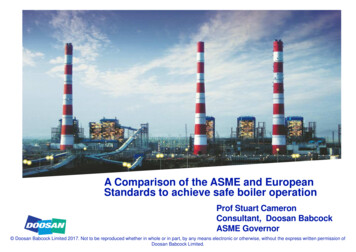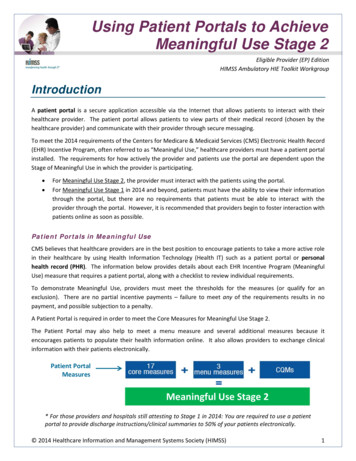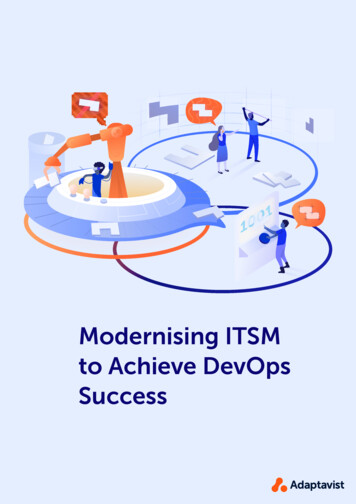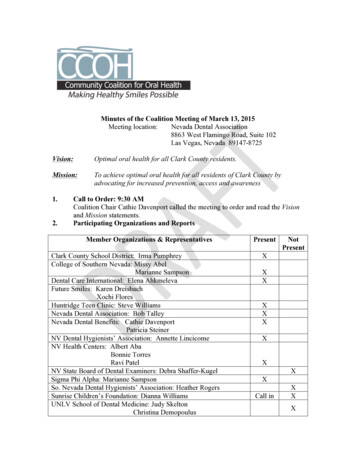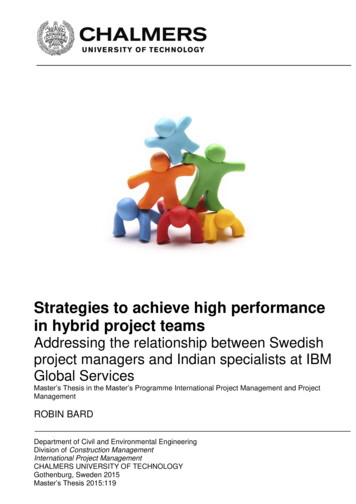
Transcription
Strategies to achieve high performancein hybrid project teamsAddressing the relationship between Swedishproject managers and Indian specialists at IBMGlobal ServicesMaster’s Thesis in the Master’s Programme International Project Management and ProjectManagementROBIN BARDDepartment of Civil and Environmental EngineeringDivision of Construction ManagementInternational Project ManagementCHALMERS UNIVERSITY OF TECHNOLOGYGothenburg, Sweden 2015Master’s Thesis 2015:119
MASTER’S THESIS 2015:119Strategies to achieve high performance in hybrid project teamsAddressing the relationship between Swedish project managers andIndian specialists at IBM Global ServicesMaster’s Thesis in the Master’s Programme International Project Management and ProjectManagementROBIN BARDDepartment of Civil and Environmental EngineeringDivision of Construction ManagementCHALMERS UNIVERSITY OF TECHNOLOGYGöteborg, Sweden 2015
Strategies to achieve high performance in hybrid project teamsAddressing the relationship between Swedish project managers and Indian specialistsat IBM Global ServicesMaster’s thesis in the Master’s Programme International Project Management andProject ManagementROBIN BARD ROBIN BARD, 2015Examensarbete 2015:119/ Institutionen för bygg- och miljöteknik,Chalmers tekniska högskola 2015Department of Civil and Environmental EngineeringDivision of Construction ManagementInternational Project ManagementChalmers University of TechnologySE-412 96 GöteborgSwedenTelephone: 46 (0)31-772 1000Cover:The Team – The picture illustrates the diversity found in a team, that individuals havedifferent skills and abilities. Matching individual’s strengths with the right activitiesand strive to continuously improve, individuals will find their spot and perform wellin the team. The outcome of their collective contribution will be greater than the sumof each individual contribution.Department of Civil and Environmental EngineeringGöteborg, Sweden, 2015I
Strategies to achieve high performance in hybrid project teamsAddressing the relationship between Swedish project managers and Indian specialistsat IBM Global ServicesMaster’s thesis in the Master’s Programme International Project Management andProject ManagementROBIN BARDDepartment of Civil and Environmental EngineeringDivision of Construction ManagementInternational Project ManagementChalmers University of TechnologyABSTRACTAIM – The aim of this research is to determine the meaning of high performancewithin a hybrid project team operating in an international setting, and how projectmanagers can govern these team members to achieve high performance.METHOD – The research design was qualitative including a single case study atIBM global services. Ten semi-structured interviews were performed in total with sixrespondents from India and four from Sweden. During the interviews open-endedquestions were asked and any ethical implications were considered.FINDINGS – To successfully govern a hybrid project team to achieve highperformance seven strategies related to project management processes and leadershipwere concluded from the findings. The on-boarding process – that enables a strongcohesiveness by having an initial meeting. The consensus planning process – thatensures a reliable time estimation of deliverables. Reliable measureable data –emphasises the importance that input data to measure project performance isreflecting reality. Frequent feedback mechanisms – that high performance is achievedwhen using both formal and informal channels to communicate feedback morefrequently. The application of small deliverables – that ensures a higher rate ofsuccessful delivery. Adaptive leadership – a project manager will need to exerciseboth guiding and supporting leadership styles to achieve high performance. Thecultural training – can increase the cultural awareness and consequently the quality ofcommunication, cohesion and performance in the team.CONCLUSIONS – This study provides an insight into the factors having an impacton performance in a hybrid project team, what defines high performance, and how aproject manager can successfully govern a team in an international setting to achievehigh performance.Key words: ibm, high performance, leadership, cohesion, motivation, virtual team,hybrid project team, strategies, consensus, feedback, culture, cultural awarenessCHALMERS Civil and Environmental Engineering, Master’s Thesis 2015:119I
1.1Background11.2Theoretical rationale11.3Research aim and research question31.4The context of the dissertation organisation31.5Research scope and limitations31.6Research methodology41.7Structure of the dissertation4THEORETICAL FRAME OF REFERENCE2.1Hybrid Project Teams2.1.1Virtual teams2.1.2Face-to-face teams5562.26Cultural dimensions2.3Team Performance2.3.1Purpose and context2.3.2Team composition2.3.3Team motivation, cohesion and rewards2.3.4Job characteristics2.3.5Team processes2.3.6Team leadership3II5METHODOLOGY78910111315173.1Research Strategy3.1.1Qualitative vs. Quantitative research strategies3.1.2Research approach3.1.3Single case study design171819193.2Interview design and data cribing3.2.4Analysing20202022223.3Research ethics223.4Research reliability233.5The research case study3.5.1IBM Global Services2323CHALMERS, Civil and Environmental Engineering, Master’s Thesis 2015:119
3.5.2456IBM Global Delivery India ProgrammeFINDINGS24254.1Main factors contributing to high performance in a hybrid project team4.1.1Purpose and context4.1.2Team composition4.1.3Team motivation, cohesion and rewards4.1.4Job characteristics4.1.5Team processes4.1.6Team leadership4.1.7Concluding summary of the sub-chapter25252729313336364.2The strategies to achieve high performance in a hybrid project team4.2.1Concluding summary of the sub-chapter3740DISCUSSION425.1Towards a definition of high performance5.1.1Purpose and context5.1.2Team composition5.1.3Team motivation and cohesion5.1.4Task significance and feedback5.1.5Team processes5.1.6Team leadership5.1.7Concluding factors to define high performance42424243444445465.2Strategies towards high performance5.2.1Project management process strategies5.2.2Leadership strategies5.2.3Concluding summary of strategies46474849CONCLUSION506.1What are the factors affecting performance in a hybrid project team?506.2What defines a high performing hybrid project team?506.3What are the strategies for achieving high performance in a hybrid projectteam?506.4Limitations and suggestions for future research517REFERENCES528APPENDICES588.1Appendix A: Interview guide8.1.1Project managers from Sweden (semi-structured)8.1.2Project team members from India (semi-structured)5858608.2Appendix B: Orientation of situational leadership628.3Appendix C: The consensus process63CHALMERS Civil and Environmental Engineering, Master’s Thesis 2015:119III
IVCHALMERS, Civil and Environmental Engineering, Master’s Thesis 2015:119
PrefaceIn this exploratory research, the researcher has defined the meaning of highperformance and the strategies to achieve high performance in a hybrid project team.The research has been carried out from December 2014 to June 2015. This work hasinvolved an extensive exploration of current literature, and interviewing with tenemployees working at International Business Machines Corporation (IBM). The studyhas been carried out to fulfil the dual award requirement for the MSc programme inInternational Project Management at Chalmers University of Technology, Swedenand Project Management at Northumbria University, UK.I would like to thank the involved interviewees at IBM, for offering their valuabletime into this research, and my supervisor Stefan Gunnarsson at IBM for the supportduring the planning phase of this research and the arrangement of Specialists humanresources. I would also like to thank Alberto Pietrobon at IBM for arranging ProjectManager human resources into this study.Especially, I would like to thank my supervisor professor Petra Bosch for the valuableguidance throughout the dissertation.And finally, I would like to thank Alan Osborne my second supervisor at NorthumbriaUniversity.Gothenburg, May, 2015Robin BardCHALMERS Civil and Environmental Engineering, Master’s Thesis 2015:119V
1IntroductionIn this chapter the author introduces the reader on the background information of thisdissertation. The introduction is further formulated to present the theoreticalrationale, research aim, briefly the research methodology, and the context of thedissertation organisation in this study. The scope and limitations and the structure ofthis dissertation are also presented. The aim of this chapter is therefore to outline therationale behind the study and to provide an overview of this dissertation.1.1BackgroundThe advancement in communication technologies is changing the possibilities in howworkplace collaboration is conducted and the processes in which organisations areexecuting their projects. By using technology and global resources, project-basedorganisations are able to perform tasks across time, distance, and organisationalboundaries. Projects that traditionally were performed locally by pure face-to-faceteams are now invited to extend the workplace to also incorporate internationalresources by utilising virtual teams. The application of virtual teams in a project canbe very cost-effective since any time and environmental impact involved in travellingwill be reduced, and also the possibility to temporary acquire a specific skill at shortnotice when needed. Even though the utilisation of virtual teams brings a variety ofbenefits, some organisations choose to work in a mixed mode combining both face-toface and virtual teams in a hybrid project team (Singh and Lano, 2014). A hybridproject team is characterised by team members that meet and communicate face-toface occasionally, whilst working virtual in the majority of the time (Fiol andO'Connor, 2005; Cousins et. al., 2007). A reason why project-based organisations arechoosing the hybrid project team type is partly because of the ability to govern theproject more closely towards the needs of the client. Further, to understand the localculture of the client, and by having the ability to acquire expertise from virtualresources when needed.1.2Theoretical rationaleA review of previous research have shown that project managers are likely toencounter a range of additional challenges when governing a hybrid project team thatutilises virtual teams and cultural diversity (Nemiro et. al, 2008, p. 353; Gibson andCohen, 2003 p.382; Bringas, 2008; MacGregor, 2007 p.236; Huang et. al, 2010;Settle-Murphy, 2012 p.3; Lee, 2013; Cousins et al., 2007). The review also shows thatthere is a relationship between the performances of the team and the implications ofpracticing different types of leadership styles within these teams (Walumbwa et al.,2005), especially when managing project members from different cultures.In the study by Johnson et al. (2002) the findings show that virtual team performanceis dependent on how well the team was able to establish procedures, resolve conflicts,and collaborate to bring about a successful task. Building trust, reading verbal andnonverbal cues were also showing to be more challenging when working in a virtualteam with less social interaction. Other challenges identified in virtual teams alsoCHALMERS Civil and Environmental Engineering, Master’s Thesis 2015:1191
linked to social interaction, were the absence of willingness to participate, engage inplanning, having individual disagreements or conflicting schedules.Lee (2013) argues that a leader must be aware of the different cultures that may existin a team. That each individual may require a unique leadership style, and thatdifferent languages or regional cultural differences could have an impact the projectsuccess. Managing cross-cultural teams is consequently relevant to team performance,since the expectation of a project is strongly affected by the cultures surrounding it.Project managers that practice leadership must therefore adapt their approach whenconfronting team members from a country in for example Asia, while that behaviourhas to change radically to get the best out of the team members located in NorthernEurope. Although a face-to-face team will experience less difficulty in the factorsabovementioned, a pure face-to-face team will lack in flexibility to acquire expertisewhen needed and work around the clock (Settle-Murphy, 2012). Mixing these twoteam types has shown to adversely affect performance, since team members only meetoccasionally (Cousins et al., 2007).Nemiro et al. (2008) highlight in their research that a high performing virtual team isplacing emphasis on team members’ cultural awareness and their commitmenttowards trust and leadership. In comparison to another study by Nelson (2010), a highperforming face-to-face team is highly cohesive and is working towards a commongoal. A high performing face-to-face team is typically acknowledging a clear purpose,is confident in overcoming obstacles, have strong interpersonal communication skills,and effective decision making methods. Also, individuals and team achievements arebeing recognized by the leader, the team members and inside the organisation.This study intends to focus on projects within a global firm. These are typicallyperformed by individuals that originate from different nationalities and nativecultures. The study as such, is therefore particularly interesting in the perspective ofgoverning a hybrid project team in an international setting. The review shows thatthere are unique challenges involved when working in a hybrid project teamcomposed by both virtual and face-to-face teams. The outcome of a project involvinginterdependent work is highly depending on the contributions of the members in ateam, the processes surrounding a project (Dyer and Dyer 2013; Mathieu
AIM – The aim of this research is to determine the meaning of high performance within a hybrid project team operating in an international setting, and how project managers can govern these team members to achieve high performance. METHOD – The research design was qualitative including a single case study at IBM global services. Ten semi-structured interviews were performed in total with six







